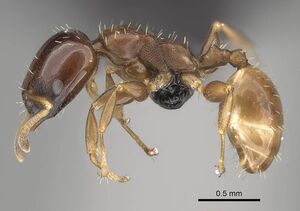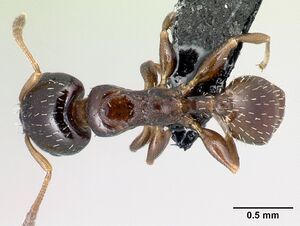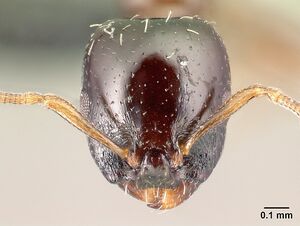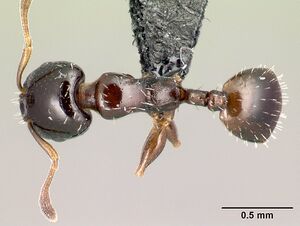Nesomyrmex brunneus
| Nesomyrmex brunneus | |
|---|---|

| |
| Scientific classification | |
| Kingdom: | Animalia |
| Phylum: | Arthropoda |
| Class: | Insecta |
| Order: | Hymenoptera |
| Family: | Formicidae |
| Subfamily: | Myrmicinae |
| Tribe: | Crematogastrini |
| Genus: | Nesomyrmex |
| Species group: | brevicornis |
| Species: | N. brunneus |
| Binomial name | |
| Nesomyrmex brunneus Csösz & Fisher, 2016 | |
This species occurs predominantly in rainforests of northern Madagascar from 25–800 m. The only southern population is reported from a rain forest of Isalo National Park. The known samples are collected from canopy: canopy moss and leaf litter or rotten pockets of live branches. (Csösz & Fisher 2016)
Identification
A member of the brevicornis species-group.
Keys including this Species
Distribution
Latitudinal Distribution Pattern
Latitudinal Range: -12.46889° to -22.48333°.
| North Temperate |
North Subtropical |
Tropical | South Subtropical |
South Temperate |
- Source: AntMaps
Distribution based on Regional Taxon Lists
Malagasy Region: Madagascar (type locality).
Distribution based on AntMaps
Distribution based on AntWeb specimens
Check data from AntWeb
Countries Occupied
| Number of countries occupied by this species based on AntWiki Regional Taxon Lists. In general, fewer countries occupied indicates a narrower range, while more countries indicates a more widespread species. |

|
Estimated Abundance
| Relative abundance based on number of AntMaps records per species (this species within the purple bar). Fewer records (to the left) indicates a less abundant/encountered species while more records (to the right) indicates more abundant/encountered species. |

|
Biology
Castes
Worker
Images from AntWeb
   
| |
| Holotype of Nesomyrmex brunneus. Worker. Specimen code casent0919844. Photographer Michele Esposito, uploaded by California Academy of Sciences. | Owned by CAS, San Francisco, CA, USA. |
   
| |
| Worker. Specimen code casent0082404. Photographer Erin Prado, uploaded by California Academy of Sciences. | Owned by CAS, San Francisco, CA, USA. |
   
| |
| Worker. Specimen code casent0107525. Photographer Erin Prado, uploaded by California Academy of Sciences. | Owned by CAS, San Francisco, CA, USA. |
   
| |
| Worker. Specimen code casent0418242. Photographer Erin Prado, uploaded by California Academy of Sciences. | Owned by CAS, San Francisco, CA, USA. |
   
| |
| Worker. Specimen code casent0428256. Photographer Erin Prado, uploaded by California Academy of Sciences. | Owned by CAS, San Francisco, CA, USA. |
   
| |
| Worker. Specimen code casent0488569. Photographer Erin Prado, uploaded by California Academy of Sciences. | Owned by CAS, San Francisco, CA, USA. |
    
| |
| Worker. Specimen code casent0418241. Photographer Erin Prado, uploaded by California Academy of Sciences. | Owned by CAS, San Francisco, CA, USA. |
Nomenclature
The following information is derived from Barry Bolton's Online Catalogue of the Ants of the World.
- brunneus. Nesomyrmex brunneus Csösz & Fisher, 2016: 137, figs 14-17 (w.) MADAGASCAR.
Unless otherwise noted the text for the remainder of this section is reported from the publication that includes the original description.
Description
Worker
Body color: dark brown; black. Body color pattern: concolorous. Absolute cephalic size: 721 [620, 808]. Cephalic length vs. maximum width of head capsule (CL/CWb): 1.14 [1.09, 1.21]. Postocular distance vs. cephalic length (PoOc/CL): 0.44 [0.39, 0.47]. Postocular sides of cranium contour frontal view orientation: converging posteriorly. Postocular sides of cranium contour frontal view shape: broadly convex. Vertex contour line in frontal view shape: straight. Vertex sculpture: main sculpture absent, ground sculpture absent, smooth and shiny. Setal pits on head dorsum: inconspicuous with obscure demarcation. Gena contour line in frontal view shape: convex. Genae contour from anterior view orientation: converging; strongly converging. Gena sculpture: ground sculpture areolate, main sculpture absent. Concentric carinae laterally surrounding antennal foramen: present. Eye length vs. absolute cephalic size (EL/CS): 0.22 [0.20, 0.24]. Frontal carina distance vs. absolute cephalic size (FRS/CS): 0.33 [0.31, 0.35]. Longitudinal carinae on median region of frons count: absent. Smooth median region on frons: present. Antennomere count: 12. Scape length vs. absolute cephalic size (SL/CS): 0.64 [0.60, 0.67]. Median clypeal notch: present. Ground sculpture of submedian area of clypeus: present. Median carina of clypeus: absent. Metanotal depression: present. Dorsal region of mesosoma sculpture: ground sculpture areolate, main sculpture absent. Lateral region of pronotum sculpture: ground sculpture areolate, main sculpture absent. Mesopleuron sculpture: ground sculpture areolate, main sculpture absent. Metapleuron sculpture: ground sculpture areolate, main sculpture absent. Petiole width vs. absolute cephalic size (PEW/CS): 0.20 [0.19, 0.22]. Dorsal region of petiole sculpture: ground sculpture areolate, main sculpture absent. Postpetiole width vs. absolute cephalic size (PPW/ CS): 0.26 [0.24, 0.29]. Dorsal region of postpetiole sculpture: ground sculpture areolate, main sculpture absent. Surface of first gastral tergite: continuously imbricate.
Type Material
Holotype: CASENT0919844, collection code: ANTC1302, P.N. Masoala, 40 km 154° SSE Maroantsetra, -15.72667°, 49.95667°, alt 150 m, A. Dejean et al., 10.14.2001 (1w, California Academy of Sciences, CASENT0919844); Paratypes: eight workers and two gynes from the same locality under CASENT codes: CASENT0004957, collection code: ANTC1302, (2w, CASC); CASENT0004958, collection code: ANTC1302, (1Q, CASC); CASENT0004959, collection code: ANTC1302, (1Q, CASC); CASENT0008660, collection code: ANTC1302, (2w, CASC, CASENT0008660); CASENT0008661, collection code: ANTC1302, (2w, CASC); CASENT0008662, collection code: ANTC1302, (2w, CASC);
Etymology
This name (brunneus) refers to the concolorous dark brown appearance of the workers of this species.

